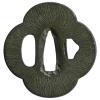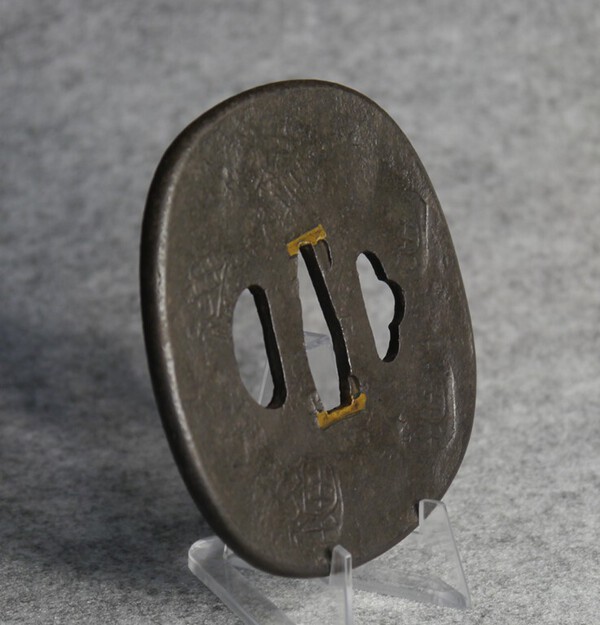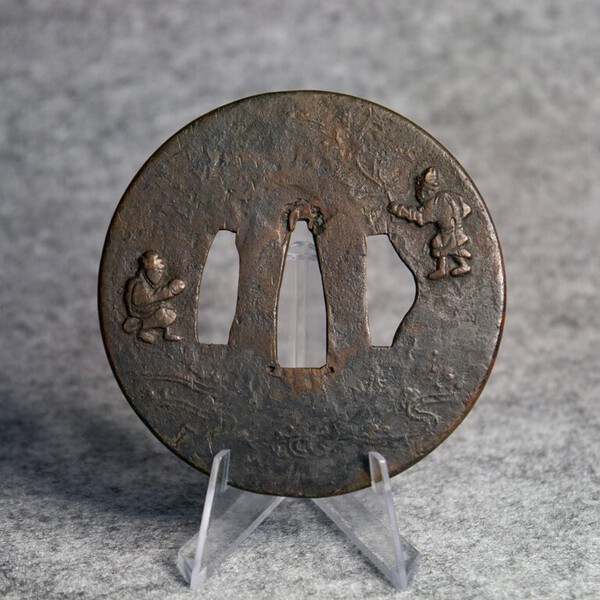-
Posts
276 -
Joined
-
Last visited
-
Days Won
1
Everything posted by Iekatsu
-
Price reduction $170 Shipping included anywhere in the world.
-
Tembo Tsuba Edo Period - $180 USD, Shipping included. Hot stamped with "Na-Mu", representing the first characters of an invocation, for example "Namu Amida Butsu". Height: 8.9cm Width: 8.2cm Weight: 171.8g Nakago-ana Height: 3.1cm Nakago-ana top Width: 0.3cm Nakago-ana bottom Width: 0.6cm
-

Yoroi and Kabuto on Aoi Art
Iekatsu replied to mas4t0's topic in Auctions and Online Sales or Sellers
Mark, The armour itself appears to be complete matching set, the finishes and fittings are decent, but not the highest quality and the condition of the various components is pretty good overall. I would treat the kamon as later additions, always buy the armour not the story. If you have any specific questions feel free to ask. I would not trust the attribution papers, the Myochin are well known for making inaccurate attributions and stretching the truth, both the kabuto and Menpo do not reflect their attributions in my opinion. All that being said, the papers were respected and taken very seriously at the time they were issued, they appear to be inline with period of manufacture and add credible provenance to the armour. If the armour was submitted for papers it would likely pass without any issues, at the price point I am a little surprised it is not already papered. 10,000,000 JPY is a lot of money and there are a lot of options at this price point, it might be worth shopping around and reaching out to some other dealers to see what is available. I hope this helps. -
I agree with the others, not Ezo. The motif is Japanese peppercorns, its common in mino work.
-
Nice Hanbo, with some interesting features. I am not sure where people draw the line with old, but it's definitely not pre Edo.
-
Alain, I am aware that it has been exhibited with the attribution, but I was wondering if there was any further provenance, was it donated to a temple, does it come from a family collection, are there clues in the Bitsu? I am just trying to gauge where the attribution comes from.
-
Interesting armour Alain, what provenance is there to tie it to Hori Hidemasa?
-
Glen, The first example in your last post is actually a Kagamishi Tsuba, its cast bronze, not etched.
-
Id put in two items.
-
A Halloween special, steer clear.
-
Sebastian, You can find the link here: https://us19.campaign-archive.com/?u=a84329d90ebce21b14f4a0c23&id=1989e759d1
-

Bonhams : The Art of the Samurai.
Iekatsu replied to Jon Masutatsu's topic in Auctions and Online Sales or Sellers
It's a little disappointing that the organisation will be judged by the perception of a single member, an organisation mind you that includes respected members of this forum and experts in Japan. You do no have to use the services of the KNKBSK, but there is room in the world for two bodies that authenticate and certify Japanese armour and equipment. Kind regards, Thomas Sinclair -

Bonhams : The Art of the Samurai.
Iekatsu replied to Jon Masutatsu's topic in Auctions and Online Sales or Sellers
To clarify the Kokusai Nihon Katchū Bugu Shinkō Kyōkai (KNKBSK) is a new professional organisation based in Japan that provides authentication and papering services to professional dealers/bodies both within and outside of Japan. The organisation is new, but this has no bearing on the quality of the rigorous appraisal process and the certificates that the organisation issues. The certificates, which can be considered a reassurance of the authenticity and quality of a piece are only issued after being appraised by a panel of experts in Japan and have multiple security features to prevent counterfeiting. Currently the organisation does not provide certification for private collectors, for these services I recommend that you contact the Japanese Armour Society. If you have any further questions feel free to contact the organisation directly via: admin@katchushinko.org Kind regards, Thomas Sinclair -
Thanks for the heads up Darrel.
-
Thanks for the images Alain, I agree with you, it looks like it was originally a Korean helmet that was converted into a kabuto, likely during the Momoyama period. The Shikoro looks to be a later addition?
-
Very nice Alain. Do you have any images of the Tehen and is any of the interior visible or is the Ukebari intact?
-
Showa Period, if it had to guess 1960's. If you post a profile image and one under the chin I will point out some of the things to look out for.
-
Very nice, could you please share an image of the interior?
-
Not quite yesterday, likely Showa period.
-
I do agree that there are very few dated examples and/or examples with reliable provenance, there is also clearly crossovers in style and construction between the Late-muromachi period and Momoyama period and the presence of later modifications to contend with, which further complicates the task. While signed and/or dated examples exist, the reality is that the vast majority of work was not signed or dated in this period, which is why it is important to compare and study the stylistic features and construction methods used and compare that with known examples. You have presented examples from Joshu Norikuni, we know that Norikuni was working in this period and that there are at least two signed and dated koboshi kabuto that we can draw from (1567 and 1569), there were also other Joshu smiths likely making koboshi in the same period, Norishige for example. But these really only represent a small subset of manufacture, given the number of extant un-signed examples which align stylistically. Unfortunately most of the examples we can draw from are unsigned and do not have particularly reliable provenance, I am in the process of building a library of such examples for comparison. Are you aware of any other dated examples from this period or examples with reliable provenance?
-
Luc, my point was that it is not an exclusive trait, there any many Koboshi from many different smiths that have three rows of rivets on the front plate.










